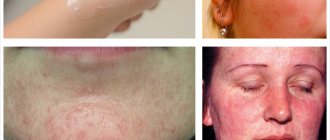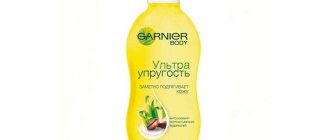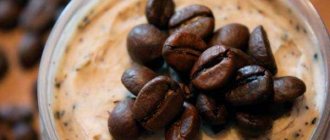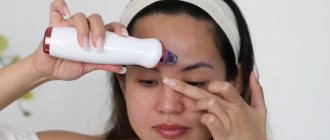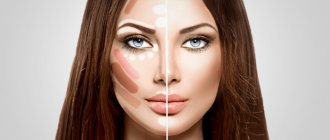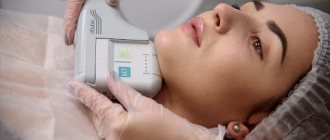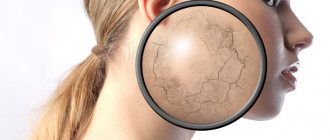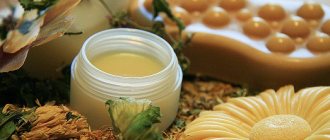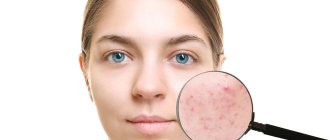What is peeling?
This deep skin cleansing procedure is aimed at exfoliating the stratum corneum of the epidermis using special products, which is extremely important for the health and youth of the skin.
It should be noted that daily cleansing of the skin with washing allows the skin to look well-groomed, but does not ensure renewal of the epidermis. Meanwhile, between the scales of the stratum corneum of the skin, particles of dirt and dust gradually accumulate, which cannot be removed by simple washing. This is where peeling the stratum corneum comes to the rescue, removing the top layer of skin along with particles of dirt and exfoliated cells. The procedure helps make the skin smoother and launch regeneration processes, because renewed skin absorbs the nutrients of creams and masks much better. The frequency of peeling of keratinized skin depends on its type, since the stronger it is, the less often the procedure can be performed.
Related materials:
exfoliation | Exfoliators | peeling | Methode Cholley | Helena Rubinstein | Elena Rubinstein | peeling mask | Dr. Brandt | Matis | matis | Ainhoa | Cream | peeling cream | Darphin | Darfan | scrub | body scrub | Korres | correspondence | Caudalie | Kodaly | GUAM | Guam | modeling products | Collistar | Colistar
Articles
- Lip care: unusual balms August 26, 2011, 00:00
- New anti-aging facial products September 11, 2011, 00:00
- Anti-aging products: new products August 29, 2013, 00:00
Video
- The magic of real lace by Helena Rubinstein October 26, 2010, 09:58
- Revolutionary new product from MATIS Cell Expert January 22, 2013, 15:40
- Super duet for skin elasticity and radiance from Helena Rubinstein August 13, 2020, 21:00
Mechanical peeling
The simplest and most affordable way to combat the thickening of the stratum corneum is a mechanical type of peeling, which is carried out using scrubs that exfoliate dead cells and smooth out the skin texture. This type of peeling can be done at home weekly (for dry skin - half as often). It should be remembered that any peeling must be done on previously cleansed skin.
The scrub is rubbed into the moist stratum corneum of the skin with soft circular movements, avoiding the areas around the eyes and lips. Then the product is thoroughly washed off, lightly patted and a nourishing cream is applied to the treated area, tapping it in with your fingertips. Never use scrubs on inflamed or diseased skin (pimples, ulcers, pustules, etc.), as their use can only aggravate the problem and lead to complications.
A scrub is a cosmetic product that contains various abrasive particles. They can be of different origins and sizes. Crushed nuts and seeds, sea sand and salt, granulated wax, etc. – all this exfoliates dead skin well. The base of the scrub is usually cream, gel or kaolin (cosmetic clay). The composition may also include moisturizing and softening components.
How to get rid of dead skin on your face
To speed up the process of skin cleansing and stimulate its renewal, it is recommended to use a method of artificial exfoliation of the skin - peeling. Peeling at home is also a cleansing and moisturizing procedure.
There are two types of peeling: biological (scrub) and chemical (deep peeling. Biological peeling at home can be carried out without much difficulty - its action is based on the mechanical action of abrasive substances. Chemical peeling at home is carried out only with strict adherence to the recommendations. We are talking about it will go lower.
Peeling at home will help you: cleanse the skin of the top layer of keratinized cells remove sebaceous plugs stimulate the outflow of sebum rejuvenate wrinkled and aging skin remove pigment spots remove soft wrinkles smooth out scars and scars improve metabolism in the skin and activate the so-called immune cells
Biological peeling at home can be done using simple foods. For example: salt, coffee grounds, soda... Let's consider simple recipes for home peelings, as well as recipes for classic chemical peels used in beauty salons.
Salt peeling at home
This salt peeling, prepared at home, exfoliates, removes the keratinized, rough layer and partially pigment spots and freckles and makes the skin “satin”.
To prepare this homemade peeling, mix 1 tbsp. l. sour cream or 2 tbsp. l. heavy cream with 1 tsp. fine salt. Using light circular movements of your fingertips along the massage lines, distribute sour cream and salt over your entire face, very gently rubbing the skin with salt.
For dry skin, use only the finest salt and half-and-half baking soda.
For dry, thin skin, mix 1 tbsp. l. oatmeal and 1 tbsp. l. olive oil (you can use any vegetable oil) with 1 tsp. finely ground salts.
For delicate sensitive skin, instead of 1 tsp. salt take 1/4 tsp. baking soda and mix with 1 tbsp. l. oatmeal, diluted with warm water (or better yet, warm yogurt or low-fat kefir) to a thick paste.
Salt peels can be used for any areas of the body where the skin is peeling, or for the entire body.
After removing the scrub, apply a moisturizing or nourishing cream or cosmetic mask. Use salt peeling at least two to three times a month to achieve silky skin, but not more than once every 7-10 days. For oily, thickened skin, you can use this peeling a little more often - 1-2 times a week. However, for the neck and décolleté area, apply peeling no more than once every 3-4 weeks, moving with soft circular movements strictly along the massage lines.
Dry, thin or delicate sensitive skin can be cleansed with a salt scrub no more than once every three weeks, be sure to lubricate it with a nourishing cream immediately after the scrub. It is most beneficial to do this procedure before bed, so that the top layer of skin has time to “rest” and recover during the night. You can use an oatmeal scrub with baking soda more often.
In the hot season, if the skin of the face has to experience direct irradiation from the sun, if you have dry, thin or sensitive skin, do not use salt scrubs, and if you have oily and thick skin, use it very sparingly.
Three light peelings from food products at home for the face for dry, thin and sensitive skin. Oatmeal and almond peeling
Mix 2 tbsp. l. - oatmeal (can be prepared in a coffee grinder from oatmeal or oat flakes) and peeled almond kernels, crushed in a coffee grinder. Separately, mix 1 tsp in a mixer. cream, 1 tsp. brewed green tea (replace with boiled water if necessary) and one drop of rose oil. Combine and mix both compositions well, let the mixture brew for 15-20 minutes.
Moisten your face with a cloth moistened with water, lightly moisten your hands with water and, warming the mixture between your palms, apply the scrub to your face and neck. Using gentle circular movements, easily massage the skin along the massage lines. It is useful to leave the scrub on the face as a mask for 10-15 minutes. Then rinse with warm water, wipe the skin with tonic lotion and apply a moisturizing or nourishing cream.
To use this scrub for oily skin, you need to add 1 tsp. oat flour and replace the cream with skim milk, and the rose oil with lemon essence.
In a simpler and faster version of this scrub, you need to brew green tea and replace 1 tbsp of rose oil. l. mashed strawberry pulp with juice, strawberries or raspberries. Peeling from citrus peels and fermented milk products
Dry the peels of citrus fruits (orange, grapefruit, tangerine, lemon) in the sun and grind them in a coffee grinder. For peeling, mix the required amount of citrus flour with natural yogurt, kefir or other fermented milk products.
Peeling at home with coffee grounds
You can use coffee grounds for peeling. For dry and normal skin, dilute the thickener with milk, cream, sour cream or vegetable oil. For oily skin, dilute the thickener with whey, yogurt or kefir.
Using the last two gentle peels, you can cleanse normal skin every other day, dry skin every 2-3 days, and oily skin every day.
If you don’t have a scrub at hand, but your skin is still peeling, you can moisten the end of a soft terry towel in warm water and rub your face with very light circular movements along the massage lines. Chemical peeling at home
And now we offer you recipes for chemical peels, which are used in beauty salons, but which you can easily do yourself at home. It should immediately be noted that ideally peeling should be carried out in a salon under the supervision of a cosmetologist. If you cannot go to the salon for some reason and decide to peel at home, then carefully follow all the precautions described below.
Please note that after this procedure the skin turns red and its top layer is completely removed, as with a moderate sunburn. This is what stimulates the formation of new cells, which leads to smoothing out wrinkles.
Chemical peeling
This common method of salon peeling of the stratum corneum of the skin is a chemical burn of the epidermis. It has different degrees of penetration (deep, medium and superficial) and differs in the type of chemical used.
TCA peeling . Trichloroacetic acid is used. The procedure includes three sessions with a break of one month. This removal of the stratum corneum of the skin is carried out in a hospital, since after the procedure quite severe swelling occurs, which requires the supervision of a specialist.
Peeling with AHA acids ( glycolic or fruit ). It is considered more gentle. It does not require a rehabilitation period and is quite effective. Glycolic peeling of keratinized areas of the skin can be performed to prevent aging, remove wrinkles, and acne. The procedure is carried out in several sessions with breaks of one to two weeks. The swelling and redness that occurs after removing dead skin disappears after about a day.
Procedures
Let's look at the types of procedures such as facial peeling, skin renewal...
Retinol or yellow facial peeling. It is called yellow face peeling because it is based on an extract from the urukum plant, which, in fact, gives it its color. Yellow peeling is the most gentle procedure; it can be done even on young skin. Indications for this procedure: pigmentation, photoaging, fine and deep wrinkles.
Superficial facial peeling is the most gentle. It is recommended for women between 25 and 35 years old, since it is at this age that a change in the relief and color of the skin is observed, and small wrinkles appear. This peeling is used for oily seborrhea, age spots and acne.
Fruit peeling of facial skin is a kind of previous peeling using fruit acids (glycolic, lactic, tartaric or malic). This peeling is usually prescribed for oily skin and acne. During a series of similar procedures and for a month after them, it is not recommended to sunbathe.
Superficial-medium facial peeling is considered the most effective, safe and simple. Before performing this procedure, the skin does not require special preparation. This type of peeling successfully fights pigment spots, photoaging, and scars after chickenpox or acne.
Gluconic facial peeling helps restore the optimal level of skin hydration and moisturize all its layers with conic acid. Gluconic acid, together with citric and lactic acids, has a moisturizing and softening property, and thanks to the introduction of green tea polyphenols, vitamin C and panthenol into the recipe, the appearance of possible inflammation is minimized.
Deep chemical peeling of the face can affect the deepest layers to correct scars, hyperpigmentation, and wrinkles. This is a very serious painful procedure that should only be performed by a qualified practitioner and should therefore only be carried out in a hospital setting.
Salicylic - deep peeling using salicylic acid, which has a strong antiseptic and anti-inflammatory effect. This type of peeling is used for severely inflamed seborrhea, acne of two degrees of severity, as well as for profound age-related changes in the skin.
